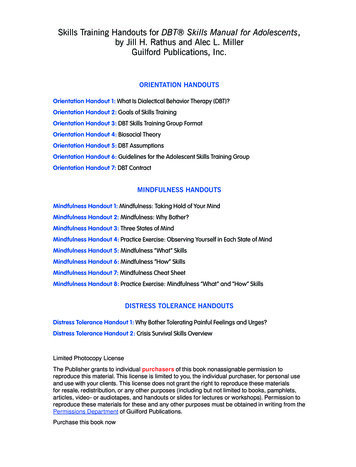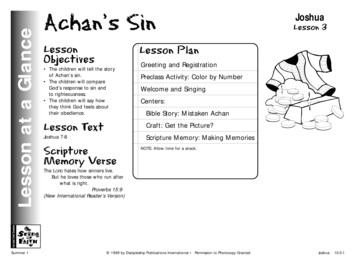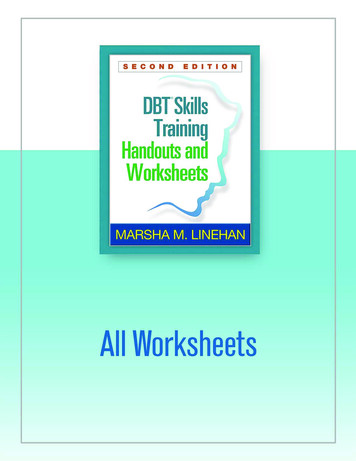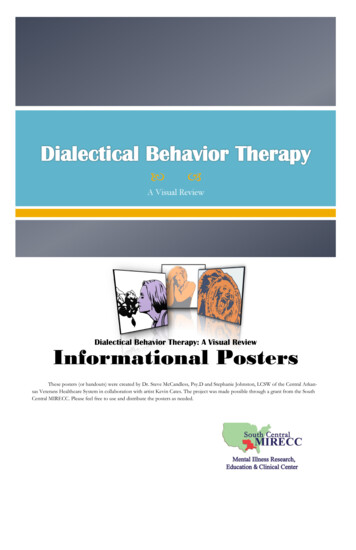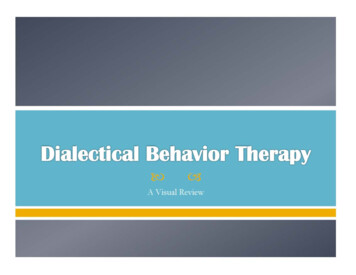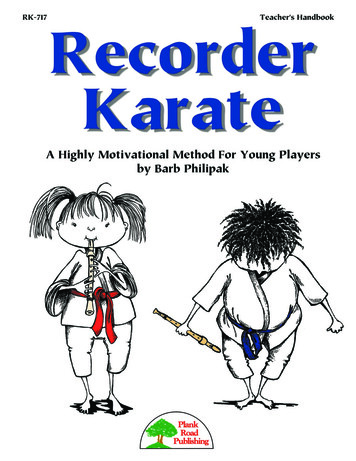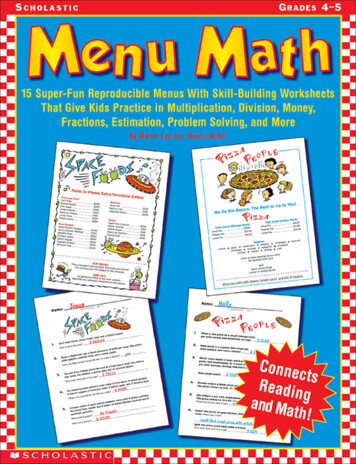
Transcription
Mindfulness HandoutsHandouts for Goals and Definitions
MINDFULNESS HANDOUT 1(Mindfulness Worksheet 1 )77.p;Goals of Mindfulness PracticeREDUCE SUFFERING AND INCREASE HAPPINESSReduce pain, tension, and stress.Other:INCREASE CONTROL OF YOUR MINDStop letting your mind be in control of you.Other:EXPERIENCE REALITY AS IT ISLive life with your eyes wide open.Experience the reality of your . . . connection to the universe. essential “goodness.” essential validity.Other:From DBT Skills Training Handouts and Worksheets, Second Edition, by Marsha M. Linehan. Copyright 2015 by Marsha M. Linehan. Permission to photocopy this handout is granted to purchasers of DBT Skills Training Handouts and Worksheets, Second Edition, and DBT SkillsTraining Manual, Second Edition, for personal use and use with individual clients only. (See page ii of this packet for details.)
MINDFULNESS HANDOUT 1AMindfulness DefinitionsWHAT IS MINDFULNESS? Intentionally living with awareness in the present moment.(Waking up from automatic or rote behaviors to participate and be present to our own lives.) Without judging or rejecting the moment.(Noticing consequences, discerning helpfulness and harmfulness—but letting go of evaluating,avoiding, suppressing, or blocking the present moment.) Without attachment to the moment.(Attending to the experience of each new moment, rather than ignoring the present by clingingto the past or grabbing for the future.)WHAT ARE MINDFULNESS SKILLS? Mindfulness skills are the specific behaviors to practice that, when put together, make upmindfulness.WHAT IS MINDFULNESS PRACTICE? Mindfulness and mindfulness skills can be practiced at any time, anywhere, while doinganything. Intentionally paying attention to the moment, without judging it or holding on to it, is allthat is needed. Meditation is practicing mindfulness and mindfulness skills while sitting, standing, or lyingquietly for a predetermined period of time. When meditating, we focus the mind (for example,we focus on body sensations, emotions, thoughts, or our breath), or we open the mind (payingattention to whatever comes into our awareness). There are many forms of meditation that differmostly by whether we are opening the mind or focusing the mind—and, if focusing, dependingon what is the focus of our attention. Contemplative prayer (such as Christian centering prayer, the rosary, Jewish Shema, IslamicSufi practice, or Hindu raja yoga) is a spiritual mindfulness practice. Mindfulness movement also has many forms. Examples include yoga, martial arts (such asQigong, tai chi, akido, and karate), and spiritual dancing. Hiking, horseback riding, and walkingcan also be ways to practice mindfulness.From DBT Skills Training Handouts and Worksheets, Second Edition, by Marsha M. Linehan. Copyright 2015 by Marsha M. Linehan. Permission to photocopy this handout is granted to purchasers of DBT Skills Training Handouts and Worksheets, Second Edition, and DBT SkillsTraining Manual, Second Edition, for personal use and use with individual clients only. (See page ii of this packet for details.)
MINDFULNESS HANDOUT 3(Mindfulness Worksheet 3 )38.p;Wise Mind:States of MindREASONABLEMINDWISEMINDReasonable Mind Is:Emotion Mind Is:CoolRationalTask-FocusedWhen in reasonable mind,you are ruled by facts, reason,logic, and pragmatics. Valuesand feelings are not important.EMOTIONMINDHotWise Mind Is:The wisdom withineach personSeeing the value ofboth reason andemotionBringing left brain andright brain togetherMood-DependentEmotion-FocusedWhen in emotion mind,you are ruled by yourmoods, feelings, and urgesto do or say things. Facts,reason, and logic are notimportant.The middle pathFrom DBT Skills Training Handouts and Worksheets, Second Edition, by Marsha M. Linehan. Copyright 2015 by Marsha M. Linehan. Permission to photocopy this handout is granted to purchasers of DBT Skills Training Handouts and Worksheets, Second Edition, and DBT SkillsTraining Manual, Second Edition, for personal use and use with individual clients only. (See page ii of this packet for details.)
MINDFULNESS HANDOUT 3A(p. 1 of 2)(Mindfulness Worksheet 3 )38.p;Ideas for Practicing Wise MindThe mindfulness skills often require a lot of practice. As with any new skill, it is important to firstpractice when you don’t need the skill. If you practice in easier situations, the skill will becomeautomatic, and you will have the skill when you need it. Practice with your eyes closed and withyour eyes open.1.Stone flake on the lake. Imagine that you are by a clear blue lake on a beautiful sunny day.Then imagine that you are a small flake of stone, flat and light. Imagine that you have beentossed out onto the lake and are now gently, slowly, floating through the calm, clear bluewater to the lake’s smooth, sandy bottom. Notice what you see, what you feel as you float down, perhaps in slow circles, floatingtoward the bottom. As you reach the bottom of the lake, settle your attention there withinyourself. Notice the serenity of the lake; become aware of the calmness and quiet deep within. As you reach the center of your self, settle your attention there.2.Walking down the spiral stairs. Imagine that within you is a spiral staircase, winding downto your very center. Starting at the top walk very slowly down the staircase, going deeperand deeper within yourself. Notice the sensations. Rest by sitting on a step, or turn on lights on the way down if youwish. Do not force yourself further than you want to go. Notice the quiet. As you reach thecenter of your self, settle your attention there—perhaps in your gut or your abdomen.3.Breathing “Wise” in, “Mind” out. Breathing in, say to yourself, “Wise”; breathing out, say“Mind.” Focus your entire attention on the word “wise,” then, focus it again entirely on the word“mind.” Continue until you sense that you have settled into Wise Mind.4.Asking Wise Mind a question. Breathing in, silently ask Wise Mind a question. Breathing out, listen for the answer. Listen, but do not give yourself the answer. Do not tell yourself the answer; listen for it. Continue asking on each in-breath for some time. If no answer comes, try again anothertime.(continued on next page)From DBT Skills Training Handouts and Worksheets, Second Edition, by Marsha M. Linehan. Copyright 2015 by Marsha M. Linehan. Permission to photocopy this handout is granted to purchasers of DBT Skills Training Handouts and Worksheets, Second Edition, and DBT SkillsTraining Manual, Second Edition, for personal use and use with individual clients only. (See page ii of this packet for details.)
MINDFULNESS HANDOUT 3A5.(p. 2 of 2)Asking is this Wise Mind? Breathing in, ask yourself, “Is this (action, thought, plan, etc.)Wise Mind?” Breathing out, listen for the answer. Listen, but do not give yourself the answer. Do not tell yourself the answer; listen for it. Continue asking on each in-breath for some time. If no answer comes, try again anothertime.6.Attending to your breath coming in and out, let your attention settle into your center. Breathing in completely, notice and follow the sensations of your breath coming in. Let your attention settle into your center, at the bottom of your breath, at your solarplexus—or Let your attention settle in the center of your forehead, your “third eye,” at the top of yourbreath. Keeping your attention at your center, exhale, breathing normally, maintaining attention. Settle into Wise Mind.7.Expanding awareness. Breathing in, focus your awareness on your center. Breathing out, stay aware of your center, but expand awareness to the space you are innow. Continue on in the moment.8.Dropping into the pauses between inhaling and exhaling. Breathing in, notice the pause after inhaling (top of breath). Breathing out, notice the pause after exhaling (bottom of breath). At each pause, let yourself “fall into” the center space within the pause.9.Other Wise Mind practice ideas:
MINDFULNESS HANDOUT 4(Mindfulness Worksheets 2–2c, 4–4b )78–48, 28–87. pp;Taking Hold of Your Mind: “What” SkillsOBSERVENotice your body sensations (coming through your eyes, ears, nose, skin, and tongue).Pay attention on purpose, to the present moment.Control your attention, but not what you see. Push away nothing. Cling to nothing.Practice wordless watching: Watch thoughts come into your mind and let them slip right bylike clouds in the sky. Notice each feeling, rising and falling, like waves in the ocean.Observe both inside and outside yourself.DESCRIBEPut words on the experience. When a feeling or thought arises, or you do something,acknowledge it. For example, say in your mind, “Sadness has just enveloped me,” or “Stomachmuscles tightening,“ or “A thought ‘I can’t do this’ has come into my mind.”Label what you observe. Put a name on your feelings. Label a thought as just a thought, afeeling as just a feeling, an action as just an action.Unglue your interpretations and opinions from the facts. Describe the “who, what, when,and where” that you observe. Just the facts.Remember, If you can’t observe it through your senses, you can’t describe it.PARTICIPATEThrow yourself completely into activities of the current moment. Do not separate yourselffrom what is going on in the moment (dancing, cleaning, talking to a friend, feeling happy orfeeling sad).Become one with whatever you are doing, completely forgetting yourself. Throw yourattention to the moment.Act intuitively from Wise Mind. Do just what is needed in each situation—a skillful dancer onthe dance floor, one with the music and your partner, neither willful nor sitting on your hands.Go with the flow. Respond with spontaneity.From DBT Skills Training Handouts and Worksheets, Second Edition, by Marsha M. Linehan. Copyright 2015 by Marsha M. Linehan. Permission to photocopy this handout is granted to purchasers of DBT Skills Training Handouts and Worksheets, Second Edition, and DBT SkillsTraining Manual, Second Edition, for personal use and use with individual clients only. (See page ii of this packet for details.)
MINDFULNESS HANDOUT 4A(p. 1 of 4)(Mindfulness Worksheets 2–2c, 4–4b)78–48, 28–87. pp;Ideas for Practicing ObservingBY COMING BACK TO YOUR SENSESRemember: Observing is bringing your mind back to the sensations of your body and mind.Observe with your eyes:1.Lie on the ground and watch the clouds in the sky.2.Walking slowly, stopping somewhere with a view, notice flowers, trees, and nature itself.3.Sit outside. Watch who and what go by in front of you, without following them with yourhead or your eyes.4.Notice the facial expression and movements of another person. Refrain from labeling theperson’s emotions, thoughts, or interests.5.Notice just the eyes, lips, or hands of another person (or just one feature of an animal).6.Pick up a leaf, a flower, or a pebble. Look at it closely, trying to see each detail.7.Find something beautiful to look at, and spend a few minutes contemplating it.8. Other:Observe sounds:9.Stop for a moment and just listen. Listen to the texture and shape of the sounds aroundyou. Listen to the silences between the sounds.10.If someone is talking, listen to the pitch of the voice, to the smoothness or roughness of thesounds, to the clarity or the mumbling of the speech, to the pauses between the words.11.Listen to music, observing each note as it comes and the spaces between the notes. Trybreathing the sounds into your body and letting them flow out again on your out breath.12. Other:Observe smells around you:13.Breathing in, notice any smells around you. Bring something close to your nose, and noticethe smells. Take it away, and then notice the smells again. Do they linger?14.When eating, notice the aroma of the food; when cooking, notice the aroma of the spices orother ingredients; when bathing, smell the soap or shampoo; when walking outside, noticethe aroma of the air; when near flowers, bend down and “smell the roses.”15. Other:Observe taste and the act of eating:16.Putting something in your mouth, pay attention to the taste. Keep it in your mouth, andnotice all the taste sensations.17.Lick a lollipop or something else. Notice just the sensation of taste.18.Eat a meal, or even a part of a meal, paying attention to the taste of each mouthful.19. Other:Observe urges to do something:When you are feeling an urge to do something impulsive,20.“Urge-surf” by imagining that your urges are a surfboard and you are standing on theboard, riding the waves.21.Notice any urge to avoid someone or something.22.Scan your entire body, and notice the sensations. Where in the body is the urge?23.When you are chewing your food, notice when you have the urge to swallow.24. Other:(continued on next page)From DBT Skills Training Handouts and Worksheets, Second Edition, by Marsha M. Linehan. Copyright 2015 by Marsha M. Linehan. Permission to photocopy this handout is granted to purchasers of DBT Skills Training Handouts and Worksheets, Second Edition, and DBT SkillsTraining Manual, Second Edition, for personal use and use with individual clients only. (See page ii of this packet for details.)
MINDFULNESS HANDOUT 4A(p. 2 of 4)Observe sensations of touch on your skin:25.Stroke your upper lip with your fingernail. Stop stroking, and notice how long it takes before you can’t sense your upper lip at all.26.When walking, notice the sensations of walking—your feet hitting the ground and rising upand down. Sometimes walk very slowly and notice. Sometimes walk very fast and notice.27.When sitting, notice your thighs on the chair. Notice the curve of your knees and your back.28.Pay attention to anything touching you. Try to feel your feet in your shoes, your body touching your clothes. Feel your arms touching a chair. Notice the sensations of your hands.29.Touch something—the wall, a fabric, a table top, a pet, a piece of fruit, a person. Notice the texture of what you feel, notice the sensations on your skin. Try it again with another part of your body. Notice the sensations again.30.Focus your attention on the sensations in your chest, your stomach, or your shoulders.31.Focus your attention on the place in your body where you feel tight or tense.32.Focus your attention on the space between your eyes.33. Other:Observe your breath: Breathe evenly and gently, focusing your attention on:34.The movement of your stomach. As you begin to breathe in, allow your belly to rise in order to bring air into the lower halfof your lungs. As the upper halves of your lungs begin to fill with air, your chest begins to rise. As you breathe out, notice your belly, then notice your chest. Don’t tire yourself.35.The pauses in your breathing. As you breathe in, notice the brief pause when your lungs have filled with air. As you breathe out, notice the brief pause when you have expelled all the air.36.The sensations in your nose as you breathe in and as you breathe out. As you breathe, close your mouth and breathe in through your nose, noticing thesensations traveling up and down your nostrils.37.Your breath while walking slowly. Breathe normally. Determine the length of your breath—the exhalation and the inhalation—by the numberof your footsteps. Continue for a few minutes. Begin to lengthen your exhalation by one step. Do not force a longer inhalation. Let it benatural. Watch your inhalation carefully to see whether there is a desire to lengthen it. Nowlengthen the exhalation by one more footstep. Watch to see whether the inhalation also lengthens by one step or not. Only lengthen the inhalation when you feel that it will be comfortable. After 20 breaths, return your breath to normal.38.Your breath while listening to a piece of music. Breathe long, light, and even breaths. Follow your breath; be master of it, while remaining aware of the movement andsentiments of the music. Do not get lost in the music, but continue to be master of your breath and yourself.39.Your breath while listening to a friend’s words and your own replies. Continue as with music.40. Other:(continued on next page)
MINDFULNESS HANDOUT 4A(p. 3 of 4)Observe thoughts coming in and out of your mind:41.Notice thoughts as they come into your mind. Ask, “Where do thoughts come from?” Then watch them to see if you can see where they come into your mind.42.As you notice thoughts in your mind, notice the pauses between each thought.43.Imagine that your mind is the sky and that thoughts are clouds. Notice each thought-cloud as it drifts by, letting it drift in and out of your mind. Imagine thoughts as leaves on water flowing down a stream, as boats drifting by on thelake, or as train cars rolling by you.44.When worries go round and round in your mind, move your attention to the sensationsin your body (those most intense right now). Then, keeping your attention on your bodysensations, notice how long it takes for the worries to ooze away.45.Step back from your mind, as if you are on top of a mountain and your mind is just aboulder down below. Gaze at your mind, watching what thoughts come up when you are watching it. Come back into your mind before you stop.46.Watch for the first two thoughts that come into your mind.47. Other:Imagine that your mind is a:48.Conveyor belt, and that thoughts and feelings are coming down the belt. Put each thought or feeling in a box, and then put it on the conveyor belt and let it go by.49.Conveyor belt, and that you are sorting thoughts and feelings as they come down the belt. Label the types of thoughts or feelings coming by (e.g., worry thoughts, thoughts aboutmy past, thoughts about my mother, planning-what-to-do thoughts, angry feeling, sadfeelings). Put them in boxes nearby for another time.50.River, and that thoughts and feelings are boats going down the river. Imagine sitting on the grass, watching the boats go by. Describe or label each boat as it goes by. Try not to jump on the boat.51.Railroad track, and that thoughts and feelings are train cars going by. Describe or label each as it goes by. Try not to jump on the train.52. Other:Observe by expanding awareness:53.Breathing in, notice your breath. Then, keeping your breath in your awareness, on thenext breath notice your hands. Then, keeping both in your awareness, on the next breathexpand your awareness to sounds. Continue holding all three in awareness at the same time. Practice this awareness of threes at other times, selecting other things to be aware of.54.Keeping your focus on what you are currently doing, gently expand your awareness toinclude the space around you.55.Go hug a tree, and feel the sensations of the embrace. Attend to the embrace of the sheets and blankets or comforters around you as you lie inbed. Do this when you feel lonely and want to be loved or to love.56. Other:(continued on next page)
MINDFULNESS HANDOUT 4A(p. 4 of 4)Open your mind to your senses:57.Practice walking with your senses as wide open as you can make them. Notice what you hear, see, and feel. Notice what you feel when shifting your weight between each step. Notice your body experience as you turn.58.For one mouthful in a meal, pause with a spoonful or forkful of food. Look at what you are going to eat, smell it, and listen to it. Then, when you are ready, putit in your mouth. Note the taste, texture, temperature, and even the sound your teeth make in chewing yourmouthful slowly. Note the changes in its taste, texture, temperature, and sound as you chew it tocompletion.59.Focus your mind on paying attention to each sensation that comes into your mind. Attend to sensations of sight, smell, touch, hearing, and taste, or to the thoughtsgenerated by your brain. Notice sensations as they arise, and notice them as they fall away. Let your mind focus on each sensation as it arises. Notice each sensation with curiosity, allowing it to be. Examine the uniqueness of eachsensation.60.Be here. Be in the present now. Take a moment to notice every sense you are aware of. To yourself, make a statement, about each sense: “I feel the chair; the chair feels me.”“I hear the heater; the heater hears me.” “I see the wall; the wall sees me.” “I hear astomach growl; it hears me.”61.When a feeling arises within you, notice it—saying, for example, “A feeling of sadness isarising within me.”62.When a thought arises within you, notice it—saying, for example, “The thought ‘It is hot inhere’ is arising within me.”63.Take just a moment of your time, and practice “nothing-to-do” mind. Let yourself become completely aware of your present experience, noticing sensationsand the space around you.64.Find a small object, one you can hold in your hand. Place it in front of you on a table or inyour lap. Observe it closely—first not moving it, and then picking it up and turning it overand around, gazing at it from different angles and in different lights. Just notice shapes,colors, sizes, and other characteristics that are visible. Then change your focus to your fingers and hands touching the object. Notice thesensations of touching the object; notice the texture, temperature, and feel of the object. Put the object down. Close your eyes, and inhale and exhale deeply and slowly. Then, with beginner’s mind, open your eyes. With new vision, once again notice theobject. With beginner’s mind, open to feeling new textures and sensations, explore theobject with your fingers and hands. Put down the object, and once again focus your mind on inhaling and exhaling once.65. Other:
MINDFULNESS HANDOUT 4B(Mindfulness Worksheets 2–2c, 4–4b)78–48, 28–87. pp;Ideas for Practicing DescribingPractice describing what you see outside of yourself:1.Lie on the ground and watch the clouds in the sky. Find and describe cloud patterns thatyou see.2.Sit on a bench on a busy street or at a park. Describe one thing about each person whowalks by you.3.Find things in nature—a leaf, a drop of water, a pet or other animal. Describe each thing inas much detail as you can.4.Describe as accurately as you can what a person has just said to you. Check to see if youare correct.5.Describe a person’s face when the person seems angry, afraid, or sad. Notice and describethe shape, movement, and placement of the forehead, eyebrows, and eyes; the lips andmouth; the cheeks; and so on.6.Describe what a person has done or is doing now. Be very specific. Avoid describingintentions or outcomes of the behavior that you do not directly observe. Avoid judgmentallanguage.7. Other:Practice describing thoughts and feelings:Describe your feelings as they arise within you: “A feeling of anger is arising within me.”Describe your thoughts when you feel a strong emotion: “I feel X, and my thoughts are Y.”Describe your feelings after someone else does or says something: “When you do X, I feelY.”11.Describe thoughts, feelings, and what you observed others do: “When you do X, I feel Y,and my thoughts are Z.” “When X occurs, I feel Y, and my thoughts are Z.”12.Describe as many of your thoughts as you can while feeling a strong emotion.13. Other:8.9.10.Practice describing your breathing:14.Each time you inhale and exhale, as you inhale, be aware that “I am inhaling, 1.” When youexhale, be aware that “I am exhaling, 1.” Remember to breathe from the stomach. Whenbeginning the second inhalation, be aware that “I am inhaling, 2.” And, slowly exhaling, beaware that “I am exhaling, 2.” Continue on up through 10. After you have reached 10, returnto 1. Whenever you lose count, return to 1.15.Begin to inhale gently and normally (from the stomach), describing in your mind that “Iam inhaling normally.” Exhale in awareness, “I am exhaling normally.” Continue for threebreaths. On the fourth breath, extend the inhalation, describing in your mind that “I ambreathing in a long inhalation.” Exhale in awareness, “I am breathing out a long exhalation.”Continue for three breaths.16.Follow the entrance and exit of air. Say to yourself, “I am inhaling and following theinhalation from its beginning to its end. I am exhaling and following the exhalation from itsbeginning to its end.”17. Other:
MINDFULNESS HANDOUT 4C(Mindfulness Worksheets 2–2c, 4–4b)78–48, 28–87. pp;Ideas for Practicing ParticipatingParticipate with awareness of connection to the universe:1.Focus your attention on where your body touches an object (floor or ground, air molecules,a chair or armrest, your bed sheets and covers, your clothes, etc.). Try to see all the waysyou are connected to and accepted by that object. Consider the function of that object withrelation to you. That is, consider what the object does for you. Consider its kindness indoing that. Experience the sensation of touching the object, and focus your entire attentionon that kindness until a sense of being connected or loved or cared for arises in your heart.Examples: Focus your attention on your feet touching the ground. Consider the kindness ofthe ground holding you up, providing a path for you to get to other things, not letting you fallaway from everything else. Focus your attention on your body touching the chair you sit in.Consider how the chair accepts you totally, holds you up, supports your back, and keepsyou from falling down on the floor. Focus your attention on the sheets and covers on yourbed. Consider the touch of the sheets and covers holding you, surrounding and keepingyou warm and comfortable. Consider the walls in the room. They keep out the wind and thecold and the rain. Think of how the walls are connected to you via the floor and the air in theroom. Experience your connection to the walls that provide you with a secure place to dothings. Go hug a tree. Think of how you and the tree are connected. Life is in you and in thetree and both of you are warmed by the sun, held by the air and supported by the earth. Tryand experience the tree loving you by providing something to lean on, or by shading you.2.Dance to music.3.Sing along with music you are listening to.4.Sing in the shower.5.Sing and dance while watching TV.6.Jump out of bed and dance, or sing before getting dressed.7.Go to a church that sings, and join in the singing.8.Play karaoke with friends or at a karaoke club or bar.9.Throw yourself into what another person is saying.10.Go running, focusing only on running.11.Play a sport and throw yourself into playing.12.Become the count of the breath, becoming only “one” when you count 1, becoming only“two” when you count 2, and so on.13.Become a word as you slowly say the word over and over and over.14.Take a class in improvisational acting.15.Take a dance class.16. Other:From DBT Skills Training Handouts and Worksheets, Second Edition, by Marsha M. Linehan. Copyright 2015 by Marsha M. Linehan. Permission to photocopy this handout is granted to purchasers of DBT Skills Training Handouts and Worksheets, Second Edition, and DBT SkillsTraining Manual, Second Edition, for personal use and use with individual clients only. (See page ii of this packet for details.)
MINDFULNESS HANDOUT 5(Mindfulness Worksheets 2–2c, 5–5c )39–88, 28–97. pp;Taking Hold of Your Mind: “How” SkillsNONJUDGMENTALLYSee, but don’t evaluate as good or bad. Just the facts.Accept each moment like a blanket spread out on the lawn, accepting both the rain and thesun and each leaf that falls upon it.Acknowledge the difference between the helpful and the harmful, the safe and the dangerous,but don’t judge them.Acknowledge your values, your wishes, your emotional reactions, but don’t judge them.When you find yourself judging, don’t judge your judging.ONE-MINDFULLYRivet yourself to now. Be completely present to this one moment.Do one thing at a time. Notice the desire to be half-present, to be somewhere else, to gosomewhere else in your mind, to do something else, to multitask—and then come back to onething at a time. When you are eating, eat.When you are walking, walk.When you are worrying, worry.When you are planning, plan.When you are remembering, remember.Let go of distractions. If other actions, or other thoughts, or strong feelings distract you, goback to what you are doing—again, and again, and again.Concentrate your mind. If you find you are doing two things at once, stop—go back to onething at a time (the opposite of multitasking!).EFFECTIVELYBe mindful of your goals in the situation, and do what is necessary to achieve them.Focus on what works. (Don’t let emotion mind get in the way of being effective.)Play by the rules.Act as skillfully as you can. Do what is needed for the situation you are in—not the situationyou wish you were in; not the one that is fair; not the one that is more comfortable.Let go of willfulness and sitting on your hands.From DBT Skills Training Handouts and Worksheets, Second Edition, by Marsha M. Linehan. Copyright 2015 by Marsha M. Linehan. Permission to photocopy this handout is granted to purchasers of DBT Skills Training Handouts and Worksheets, Second Edition, and DBT SkillsTraining Manual, Second Edition, for personal use and use with individual clients only. (See page ii of this packet for details.)
MINDFULNESS HANDOUT 5A(Mindfulness Worksheets 2–2c, 5–5c)39–88, 28–97. pp;Ideas for Practicing NonjudgmentalnessLeaving out comparisons, judgments, and assumptions:1.Practice observing judgmental thoughts and statements, saying in your mind,“A judgmental thought arose in my mind.”2.Count judgmental thoughts and statements (by moving objects or pieces of paper fromone pocket to another, by clicking a sports counter, or by marking a piece of paper).3.Replace judgmental thoughts and statements with nonjudgmental thoughts and statements.Tips for replacing judgment by stating the facts:1. Describe the facts of the event or situation—only what is observed with your senses.2. Describe the consequences of the event. Keep to the facts.3. Describe your own feelings in response to the facts (remember, emotions are notjudgments).4.Observe your judgmental facial expressions, postures, and voice tones (includingvoice tones in your head).5.Cha
Ideas for Practicing Wise Mind : The mindfulness skills often require a lot of practice. As with any new skill, it is important to first practice when you don’t need the skill. If you practice in easier situations, the skill will become aut
